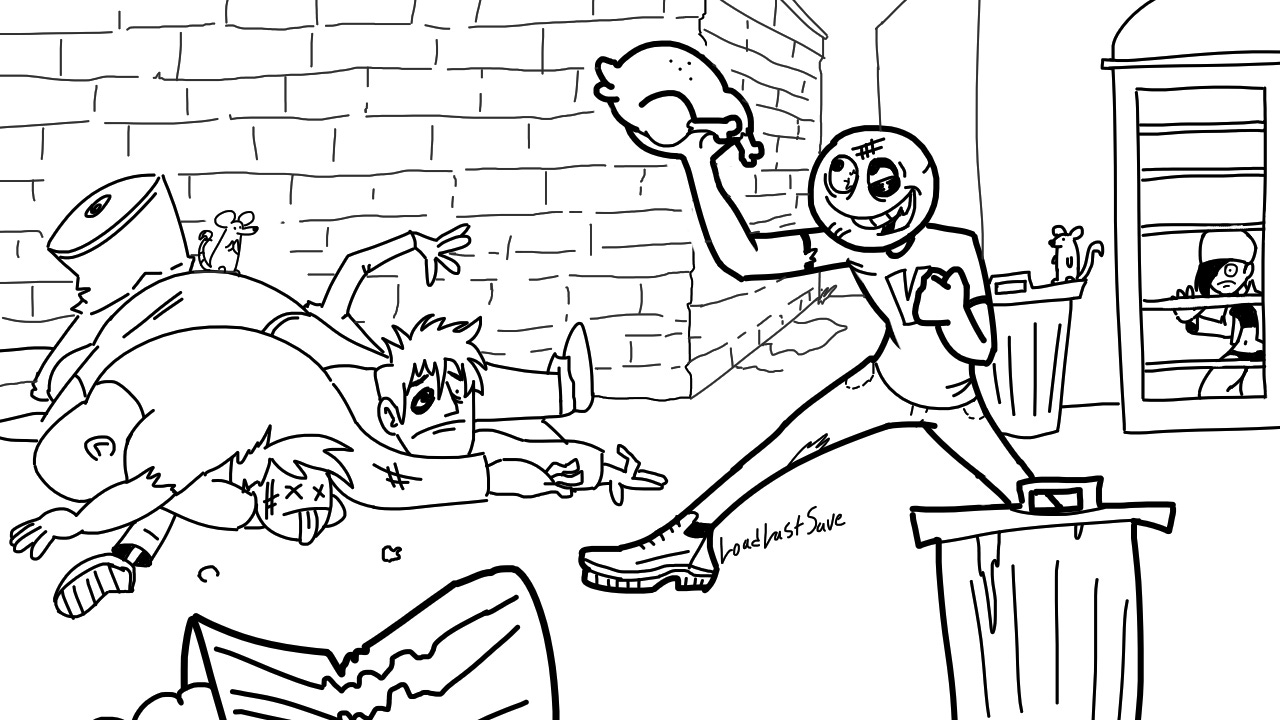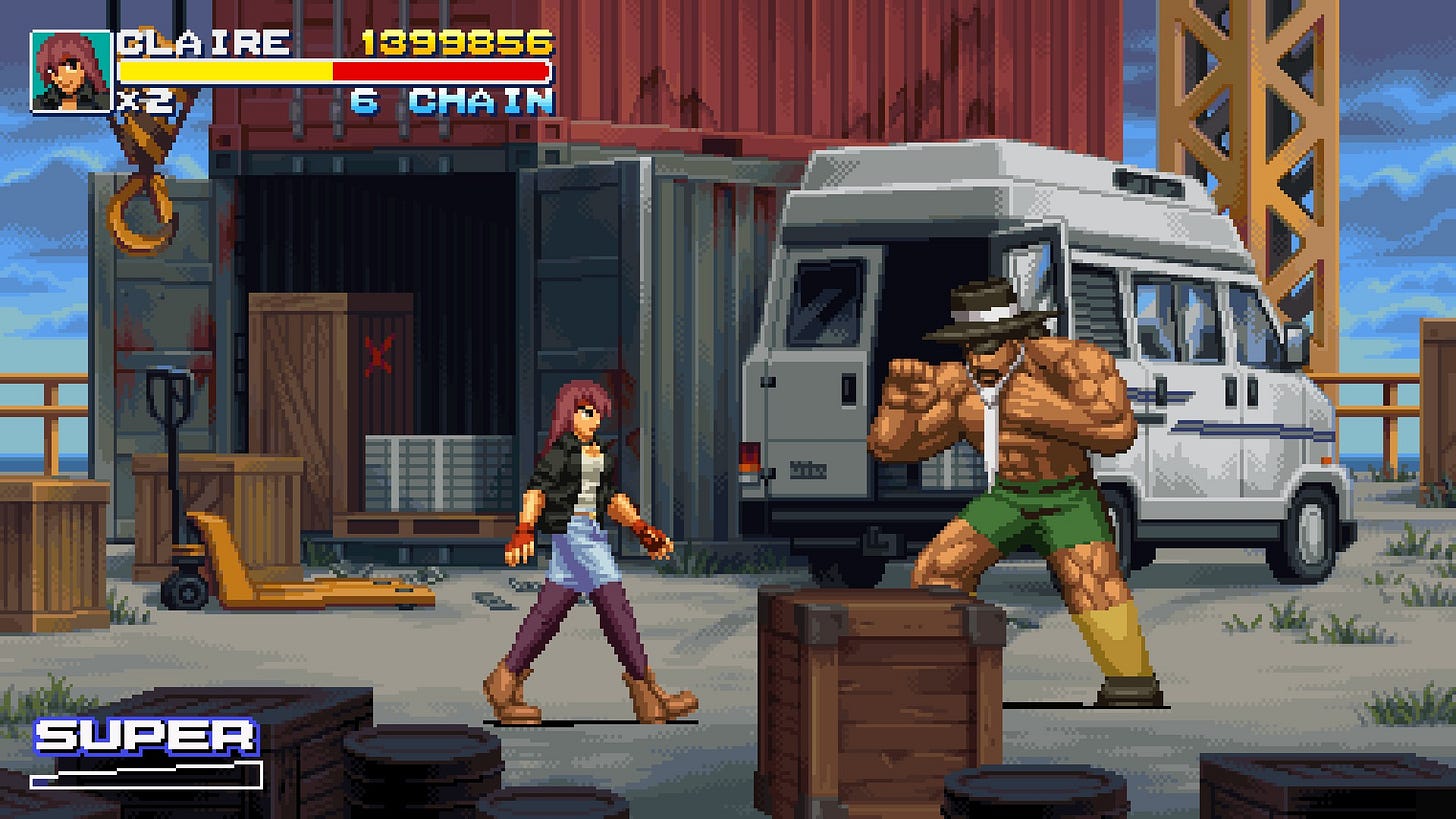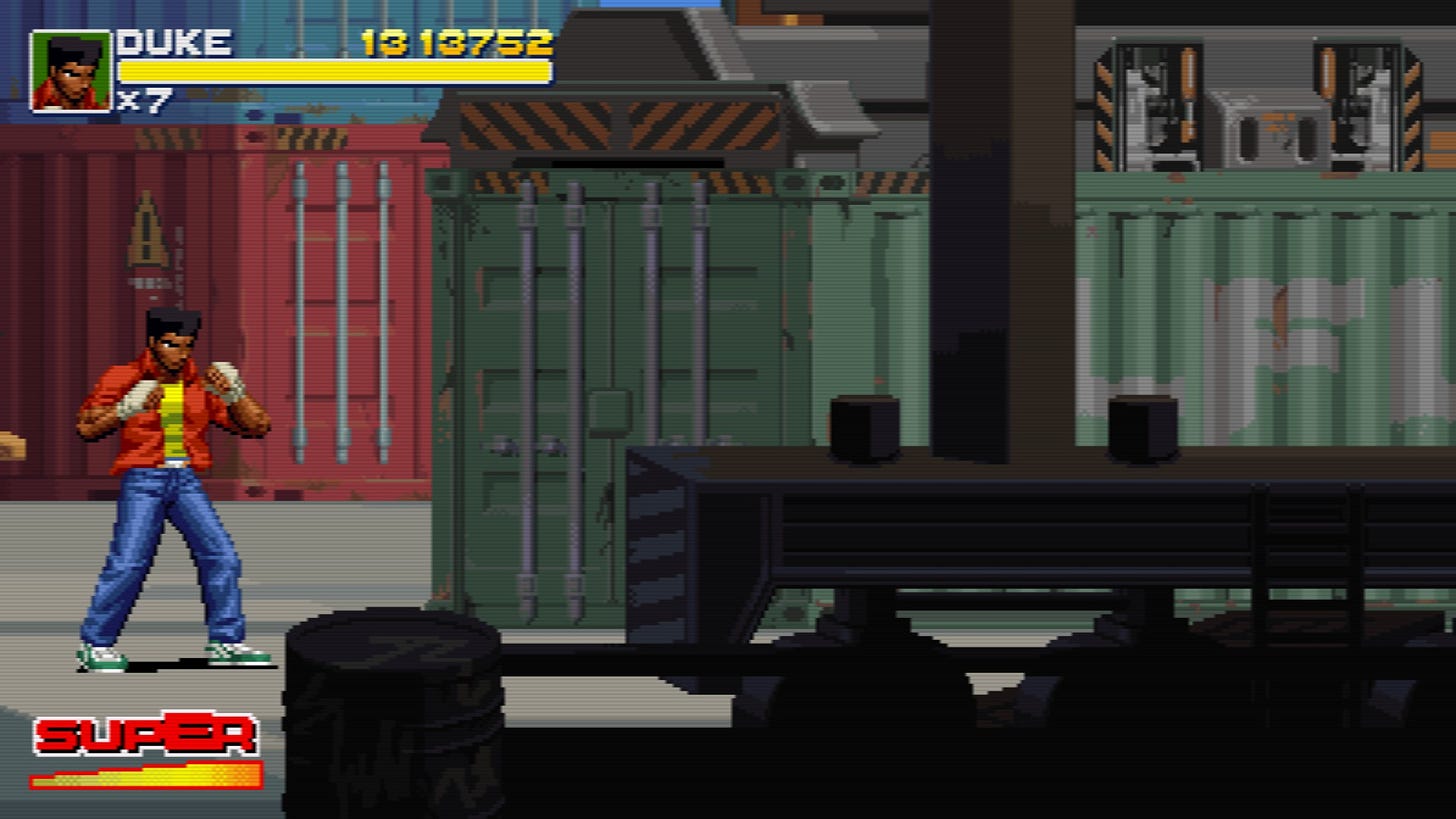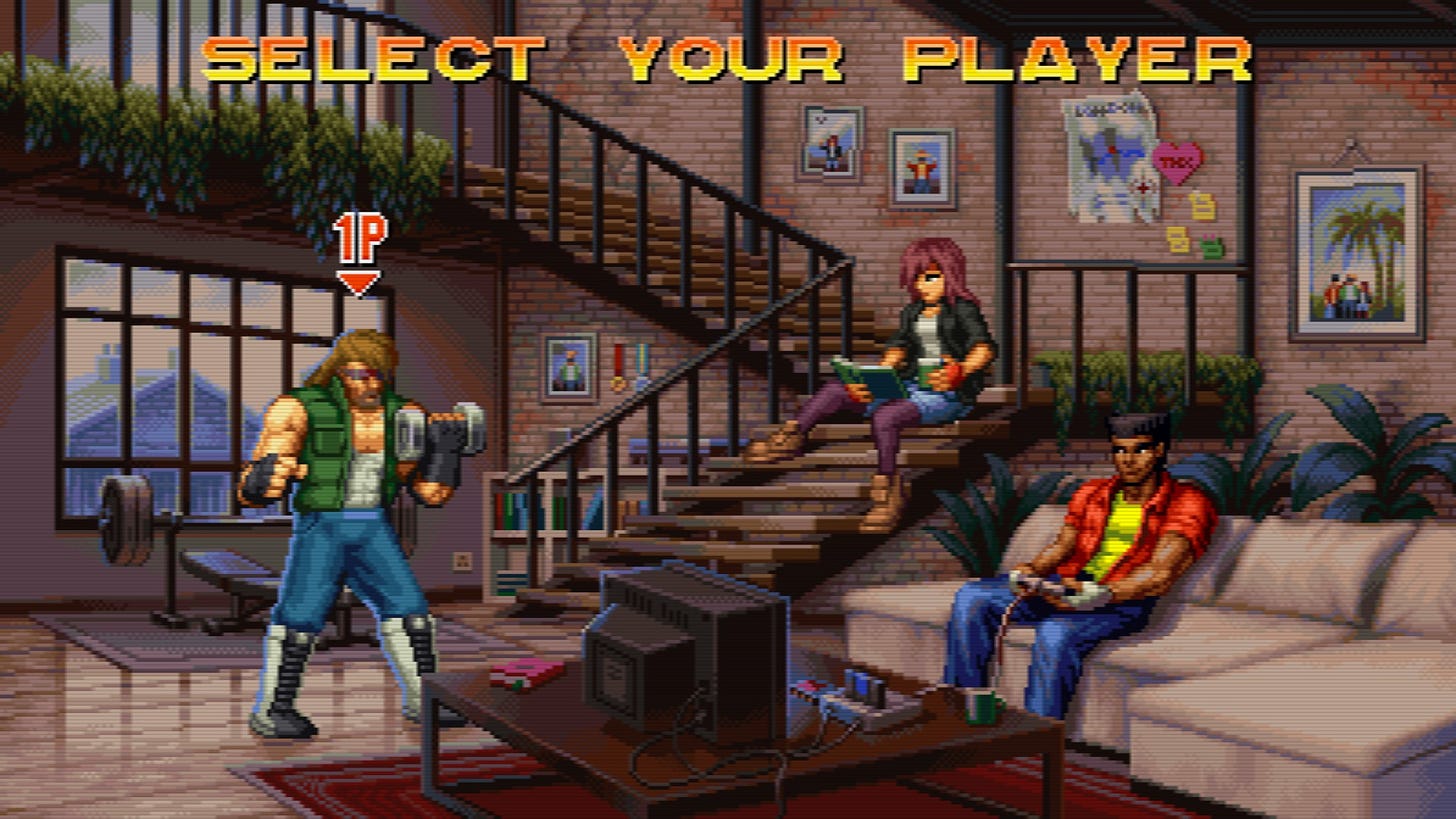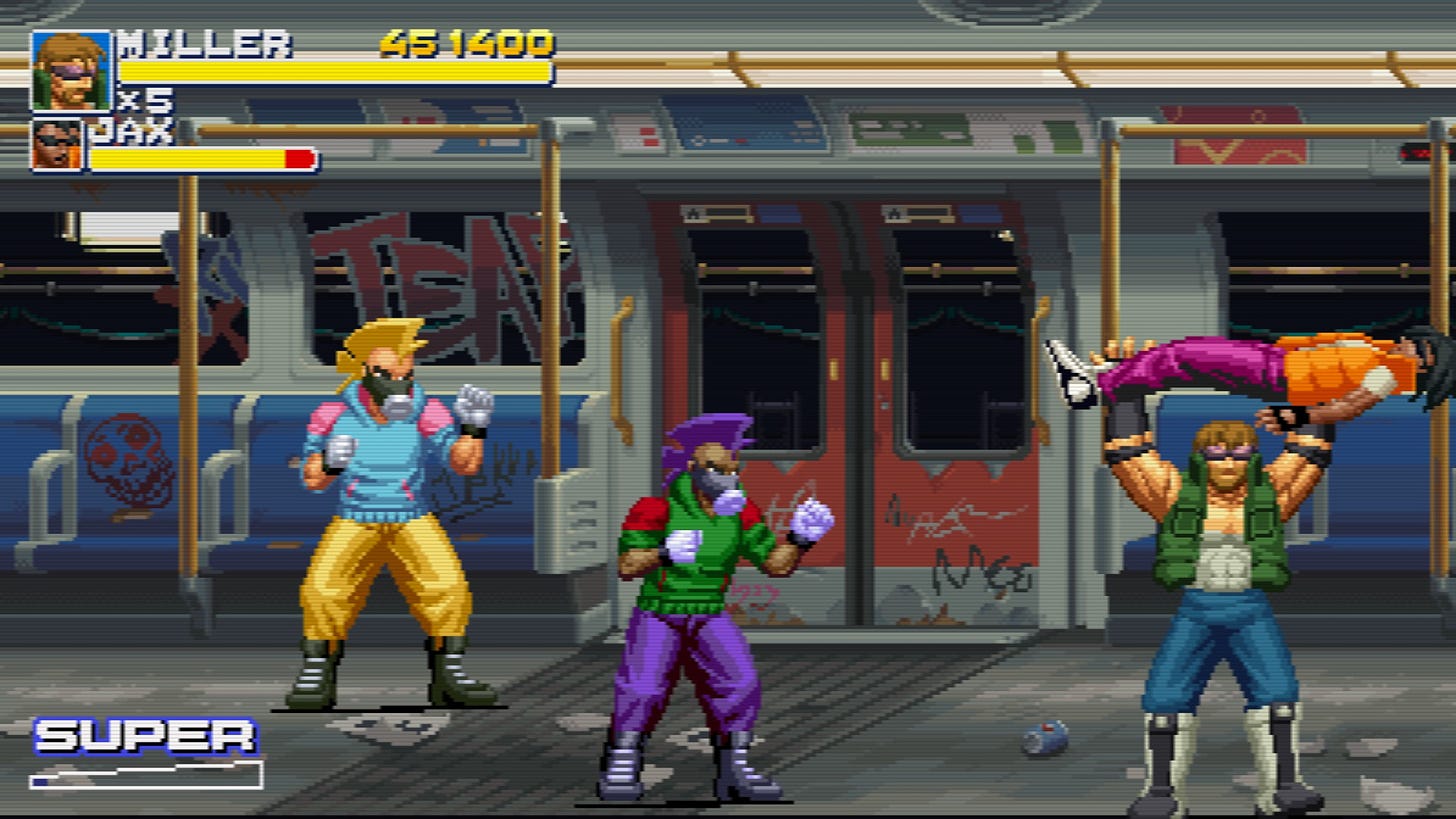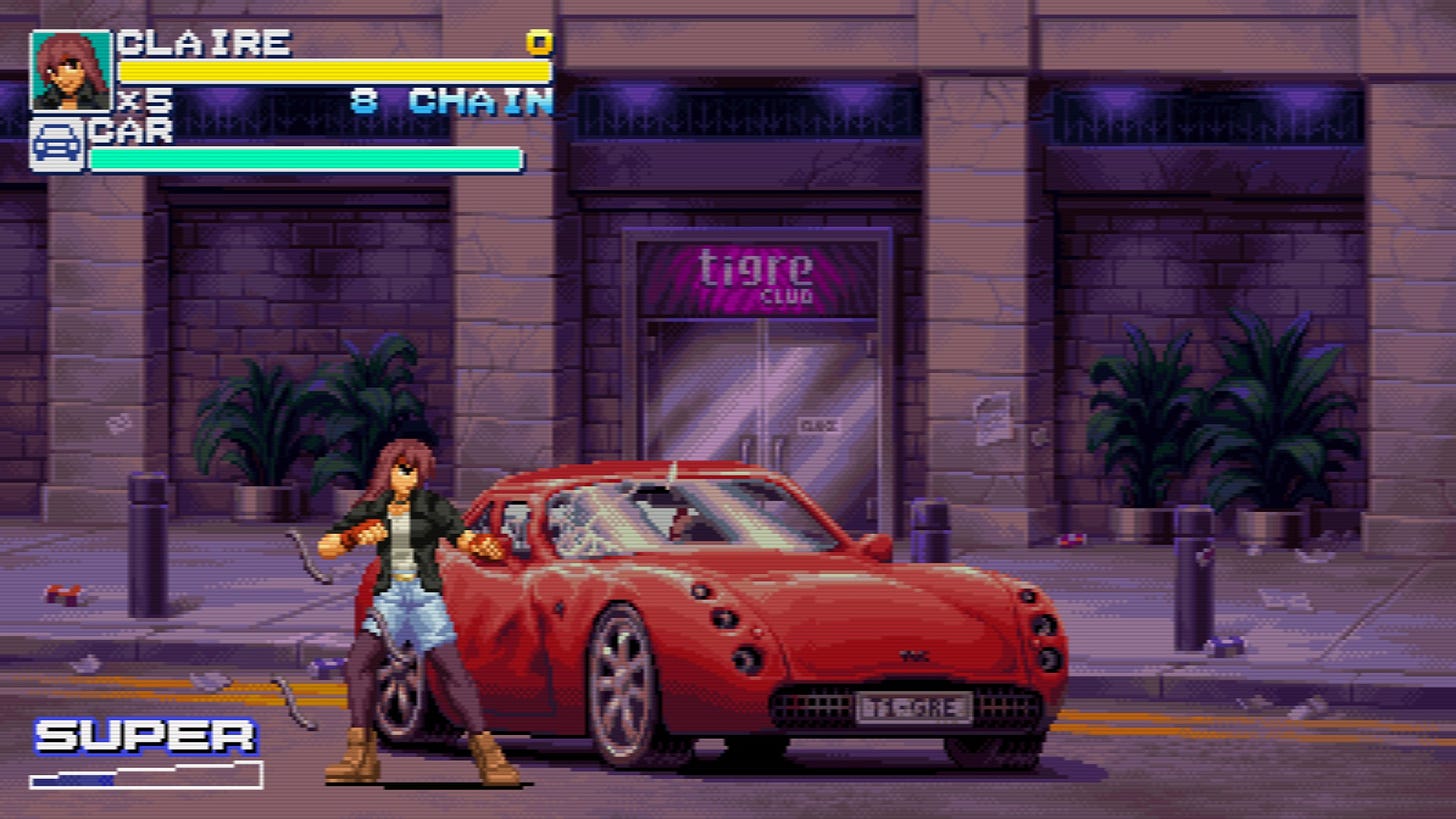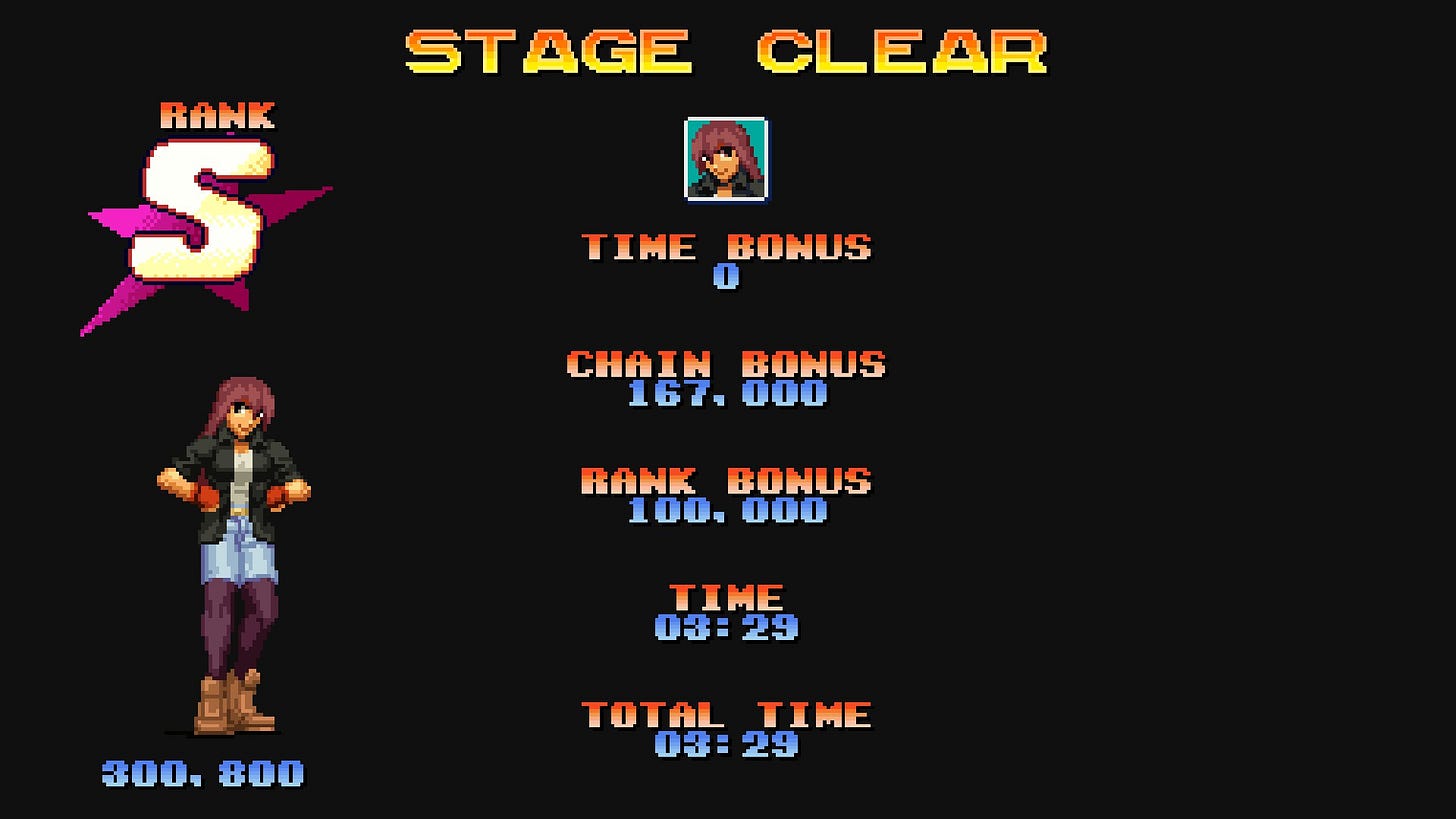There are a lot of games nowadays that try to capture the “retro” and “old school” feel of old arcade games. Stuff like the GI Joe game, TMNT: Shredder’s Revenge and the Karate Kid game. They all try to invoke nostalgia with pixel graphics and co-op beat-em-up gameplay like in the good ol’ days of your youth when you still had hair and didn’t have to pay taxes. Relive the glory days with these games! They say. “Look, they’re brainless quarter munchers from a simpler time!”
Needless to say they miss the mark. They don’t understand what makes the genre fun or how to make one that will be enjoyable after the initial nostalgia buzz fades. But old beat em ups were just that, right? Dumb little button mashers for drooling infants to play in the arcade while their mom shops for shoes.
In comes Final Vendetta, a game that not only manages to capture the real spirit of a classic arcade beat em up, it’s also a damn good game, too. It has a full understanding of the subtleties of good arcade design and delivers a solid, replayable game that would not have been out of place among the top of the pile in the arcade back in the 90s.
Gameplay
Final Vendetta is a 2D side scrolling Beat-em-up. You pick from one of three characters and go through six stages with tons of thugs to punch, weapons thrown around, and entire roast chickens hidden in trash cans. Delicious.
The main form of interacting with the game world is through punching. There’s the standard one button attack combo that ends in a knockdown. It’s quick and it has good reach, meaning you can space enemies out while staying relatively safe. When an enemy gets hit, they flinch for a long time, allowing you to reposition between strikes. This lets you lock an enemy down and then move in for a grab or manage a large group. The basic combo has a long combo timer which prevents you from stun locking enemies with the first few hits like in the original Streets of Rage, but thanks to the long hit stun and quick movement, you can go for a hit-and-run approach where you smack an enemy with the first few hits of the auto combo, move back to reset the timer and go for a quick jab-lock. This is good for keeping your combo going against bosses. Overall, the basic punch is a very strong tool that feels powerful and useful, even when facing overwhelming odds.
Along with the regular punch, there’s the rest of the standard tool kit you’d expect in a beat em up: jump attacks, back attacks, a desperation move and a grab.
Out of all those I think the grab and the desperation move deserve a mention. Grabbing an enemy is incredibly useful. Not only does it let you damage enemies that are blocking, but it lets you forcefully reposition people. Thrown enemies also have a massive hitbox that knocks anyone down. While throwing enemies you’re immune to attacks. You can confidently enter a crowd of thugs and throw them around like sacks of flour with great results. It’s a reliable tool that lets you control entire rooms.
The desperation move is an attack that hits anyone around the player and knocks them down. These are used when you’re surrounded, since they hit in a large area, including above and below, and are invincible. The trade off is that they cost health to perform. That’s how it is in other games, but in Final Vendetta you have a super meter. When that meter is full, you can use the desperation attack for free, so you don’t have to be shy with it. If it’s used without a full meter, it costs health as you would expect, but even then the health cost isn’t too steep.
The next fundamental ingredient is movement. You have your regular walk, and a sprint. The regular walk is fast, making it easy to weave in and out of your opponent’s range, and it makes it possible to avoid a lot of attacks just with spacing alone. The sprint is used to cover long distances quickly and to initiate a dash attack, which knocks enemies down and has a good area of effect.
There’s also a sidestep dodge. This allows you to move up and down quickly to avoid attacks. By combining the dodge input with left or right you can dash diagonally to cover large distances. It’s also possible to cancel out of the auto combo using the dodge, but the exact timing is a bit tricky. Doing this resets the combo, meaning you can cancel out of the combo, then dash back in for a stun lock and repeat. I haven’t found much use for this other than some very specific situations where I managed to put an entire group of enemies to one side of the screen and looped this for a bit, but I could have gotten better results by using the full combo and knocking everyone down.
There’s also a block, which lets you block attacks. That’s what it does. I forget that it’s there. It might have some use, but moving out of the way works perfectly fine to avoid any attack. When it comes to defense in most games, I follow Viewtiful Joe’s philosophy: A real superhero doesn’t do blocks; he dances out of trouble!
How does this all come together? All these fundamental techniques are strong and effective, which makes the player feel powerful. Any challenge can be overcome thanks to the tools available to you at any moment. If you’re surrounded you can make use of the generous desperation attack to get some breathing room, but with everything else in your arsenal you can prevent that from happening in the first place. Jab an enemy to lock them down, then move in to grab them and throw them into their buddies. The player is always in control.
With all these strong basic techniques you’d think the game would be a cakewalk, but no, it offers a good challenge. Enemies are numerous and angry. They want nothing more than to grind your face into the concrete and take all your lives. It’s one thing to have the tools to deal with any situation, using them correctly is another story.
If you learn all these skills well, you get rewarded with a good score. At the end of each stage you’re graded on your performance based on how much life you had at the end of the level, how quickly you cleared the stage and the highest combo you achieved. The combo system is a simple, yet effective chaining system. As you fight, a counter goes up. After some time without hitting anything or when you’re knocked down, it resets. The higher it gets, the more points you get. What I like about this system is that each stage is designed to keep a full combo going, with barrels and enemies placed to keep the chain. Except for Stage 4. There’s an area in stage 4 with a falling container that kills your chain because no enemies spawn and there’s nothing to punch for a while. I haven’t found how to get through that with the combo intact. Other than that hiccup, it’s a simple but effective chain system.
Enemies
Every one of these 80’s-styled punks comes equipped with their own move set, behavior and bad attitude. There’s the basic grunt who walks around and tries to punch you, the whip girl who suddenly leaps at you and the knife guy, closest to a Galsia-type, who is a stab-pilled knife maxxer who dashes forward with a knife instead of running. Some attack from the front, others will jump over you and attack from the air. They are distinct enough in their patterns to be noticeable.
Alone they’re a nuisance, but when they combine, they form a mighty Voltron of pain. Each screen in the game is staffed by groups of hand-picked enemies. These punk platoons interlock to form multi-faceted attack patterns. One screen in The Underground has you fighting a large group of straight forward ground-based thugs, when suddenly two acrobatic knife guys jump in. They stay behind the ground thugs and jump over them to throw knives down at you. That particular area would be a breeze if you took out the knife guys, but it’s a lot easier said than done when you have to take care of a wall of regular delinquents that serve as cover.
The way they move and approach the player is good, too. They don’t just charge at you or attack willy-nilly. They will try to surround you, attack from far away if you’re distracted with another enemy. They will circle around and avoid attacks. There is one enemy type, the gas mask wearing punks, that get in close then dodge behind the player if they attack. Enemies use every pixel of the screen effectively to force the player to act and move. The only downside is that they also use some pixels off the screen; the sides have a lot of space where enemies can get knocked off-screen and they take their sweet time getting back in the play field.
This might sound like basic game design, and it is, but Final Vendetta pulls this off tremendously. In a game so simple as a beat-em up you need to have rock-solid fundamentals to keep things fun and challenging. Fun + challenging = interesting, and interesting is the opposite of boring. Quick maths.
Characters
You get to pick from one of three characters. From left to right:
Miller: The grappler. He is slow but does a ton of damage. His attacks have massive hit-boxes and he can grab enemies and slam them in a backbreaker for an insane amount of damage. You can even use it on bosses and they melt. His downward air attack is a flying elbow that knocks down anyone in the area and hits grounded enemies.
He’s tons of fun, but there are two things I don’t like about him: First is the fact that he can’t carry enemies or air slam them. In these kinds of games, the grappler can usually hold enemies and carry them around, and they have a giant piledriver where they jump and slam an enemy into the ground. Haggar doesn’t do that in the original Final Fight, but he can carry people. Boris from Violent Storm can do it, so can Major Schaefer from Alien vs Predator, among others. This is more of a personal gripe, but still, piledriving someone into a crowd is always top-tier fun.
The second complaint is that the second hit of his auto combo has less range than the first hit. It whiffs more than I think it should.
Claire: The speedy one with low power, the Blaze. She is quick and can set up some ridiculous juggles with her kicks and a few micro dashes. She has a special move that does okay damage and sends enemies flying. It comes out in a few frames and it’s a great crowd control tool. She’s also technically the main character, since the plot revolves around her rescuing her sister.
I have a nitpick about her design that should be obvious at first glance. It’s like that one observation hack comedians make: “You ever notice that when you get fast food, it never looks like it does in the pictures?”. This is what happened with Claire. This isn’t a problem exclusive to her, either. The other female enemies also look like that in-game. The only way I can describe it is “narrow”, like they were squished on the X-axis. They could use a burger or two.
Duke: The all-rounder. Balanced in speed and power, the Axel of the group. His knockdown attack is a kick with great range that can be spammed for easy crowd control. His basic combo has good range, speed and damage. His special move is a flurry of punches that’s perfect for juggling enemies and it does a good chunk of damage. The only downside to it is that it takes a while to complete, so you’re stuck in a long animation while doing it. Make sure you’re safe before throwing it out. I don’t have any real complaints with Duke. He’s fine. He’s a gamer, so he gets bonus points. Great flat top, too. Sharp 90-degree angles on it. Whichever barber lined that up must have used a ruler.
All three characters are distinct enough from one another to be memorable and have something to offer. My favorite is Miller. Beating a boss by breaking their spine is always satisfying.
Presentation
This is where my opinion on this game shifts a little. It’s technically good, as in technique-wise. It looks good, it has great animations and everything on screen is always readable and identifiable. The visuals match what’s happening well, no weird hitboxes (most of the time) or issues with depth-perception.
The pixel art is good, too. It takes a lot of inspiration from the King of Fighters series, with its lines of shading on the pants and big, chunky pixels. Each character and enemy looks distinct from one another, they have easily recognizable silhouettes, they have unique poses and idle animations, and their attacks all look great.
Thing is, Final Vendetta, we need to talk about your flair. It’s heavily inspired by Final Fight, and it shows, a little too much. Its stages are almost a one-to-one copy in terms of visuals, theming and even order. The first stage is a fight through a run-down alley battling thugs and breaking trash cans. It even has telephone boxes like in Final Fight and enemies coming out of the background. The second stage takes place in the subway, like in Final Fight, complete with areas on the platform and inside the trains. There’s a club stage and even a level inside a mansion complete with falling chandeliers and everything. It gets a little blatant at times, but it doesn’t copy any of the weirder elements.
It cribs a lot of aesthetic and thematic elements from Final Fight, but not its wackier points. There’s an industrial level, but it’s in a regular shipyard and not in a factory where you’re dodging flames and machinery. Same with the enemy’s visual design: a lot of 80’s looking thugs in bright clothing and puffy vests, street clothes and such. Nothing too out of the ordinary or visually unique. A lot of beat em ups from the 80s and 90s had you fighting street thugs, but they gave them unique, bizarre looks. A lot of visors, mohawks and spiked accessories. They looked similar to each other at times, sure. Violent Storm, Final Fight, Vendetta (the regular one, not Final), Double Dragon, Streets of Rage and others I’m forgetting all had “Punk with a leather jacket and a mohawk” as enemies, but at least they were interesting. They were larger than life caricatures. Violent Storm had bizarre mutant weirdos, Streets of Rage had clowns that juggled fire. Final Vendetta takes that same approach but stops right before they hit anything too interesting. You won’t see any ten foot tall muscleheads or guys with green skin.
Maybe they wanted to make something more realistic and down-to-earth. You’re fighting regular people, in regular locations. Then why do you fight a teleporting scientist and an android?
It bothers me because the rest of the game is so good, but then they didn’t go 100% on its visual identity. It’s a fundamentally solid game with a lot of thought put into the mechanics and gameplay, but not much to the setting and visuals.
Soundtrack
Good thing the music is there to pick up the slack. It has a soundtrack featuring the Utah Saints, and they bring some bouncy, dance-worthy tunes that fit the action perfectly. It’s big, it’s loud, it’s what the visuals should have been. The tracks sound like forgotten dance hits from the 90s in the best way possible. Lots of driving percussion, melodies delivered with bright, groovy synths, jazz hits and great use of vocal samples.
It covers a few subgenres while maintaining a cohesive aesthetic. Some tracks are more hip-hop oriented, like the theme for stage 2. Stage 3’s boss, the Scientist, has a theme that features a sick, filthy breakbeat drum and a scientific-sounding synth melody on top. The “Oooh yeah” vocal samples, a staple of 90s dance music, tie it all together and help keep it stylistically aligned with the rest of the soundtrack.
I say the soundtrack does what the graphics don’t because they both try to emulate a specific style, but one does it well and the other does it well while also giving it a unique flair. The soundtrack is the second one. The graphics and the game’s overall presentation, its world, its enemy design, all go for that 90s Streets of Rage/Final Fight look but it doesn’t give it its own personality. It’s imitating that style because it’s a sort of spiritual successor/homage to those games, but I think Final Vendetta had enough in its tank to warrant a bit more pizzazz. The soundtrack manages to capture that same time period and feeling, while also making it sound fresh.
The overall sound design is good, too. The hits sound impactful, with some good cartoon punch sound effects. Environmental objects give nice feedback when hit and when you pick stuff up it has a fun beep-bloopy arcadey sound.
Conclusion
Final Vendetta is a great game. Its basic gameplay is rock solid and demonstrates a deep understanding of Beat-em-up fundamentals. The movement speed is great and it allows you to dodge attacks, attacks are meaty and the controls are responsive. You have a tool for every situation, and they are all powerful. It has six stages, all perfectly paced with a good level of challenge and a lot of enemies to fight. It’s the closest a game has gotten to capturing the essence of a retro beat em up, like what these lame new licensed games like the GI Joe or Karate Kid games try to be.
The thing is that it has a very solid fundamental base, but it doesn’t build much on top of it. It’s almost academic in a sense. It’s a textbook game. Everything it does it does very well, but it doesn’t do anything new. If you want to learn what makes a good beat em up, how it works and how to make one you can study the classics, and Final Vendetta. It takes a lot of the things that work from those old games and polishes it enough to make it feel more “modern” in a sense.
If it does that, then why am I complaining about it not doing anything flashy? Because it doesn’t really have its own hook. It doesn’t have one stand-out mechanic I can point to and say “That’s Final Vendetta right there!”.
Does that make it a bad game? Of course not. It’s not a boring game, either. The reason why I’m giving it a hard time for its lack of flair is because the game itself is great. Like I said, it understands the fundamentals perfectly. It has great pacing, every level feels like a challenge without overstaying its welcome. The entire game can be completed in around 40 minutes, but it’s not easy. It’s fun and has enough tools to play around with to meet every challenge.
The difficulty is something I hadn’t mentioned. The game sticks to its arcade design through and through. It has a lives and a scoring system where you can get more lives every 1,000,000 points. It has to be cleared in one credit, meaning that if you run out of lives it’s game over. No continues. A lot of people were complaining about this, saying that it was too hard and that they wanted to see the whole game instead of getting stuck on the first few stages. To those people I say: Eat more protein. I love that the game demands you play it right. If you want to beat it you will get good at it, and it’s entirely possible to do so. The game’s difficulty isn’t cheap or annoying. It’s a deliberate challenge that can be overcome with enough practice and patience, like an arcade game should be.
The game has enough tools to help you practice and learn patterns. It has a training mode where you can fight against individual enemies, including bosses, and practice them as long as you want. It also has a stage select so you can repeat specific levels and try to get better at them.
There were also a lot of complaints about the price. Twenty five dollars for a six level arcade game is too much for a lot of people. Same thing with Rise of the Ninja- Reborn. Like I said in that review, value is subjective. I could spend another 6,000 words telling you how great Final Vendetta is, but if you don’t think it’s worth $25, I can’t convince you. What I can say is that it was worth it to me. I think it’s good enough to earn its full price. It’s only six levels but each level is well crafted and the game itself is very replayable.
In short, if you like real arcade games and you’re looking for a new beat em up to play, you should give Final Vendetta a shot. It’s an expertly crafted game with a great understanding of fundamentals that manages to make a fun, rewarding and replayable experience with a boppin’ soundtrack, even if its aesthetic choices and lack of flashy mechanics leave a little to be desired.
I don’t say this because it’s disappointing, I say it because the game is great, and I think they could have come up with some great mechanics to go along with it. To go back to the fast food analogies, it’s a delicious burger, but I would have liked to see what it would taste like with a little mustard. I should stop writing these reviews before lunch.
You can get Final Vendetta on PC and all home consoles.



